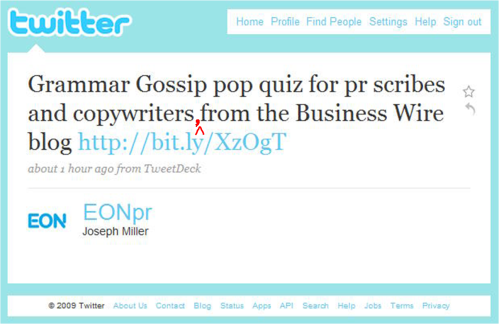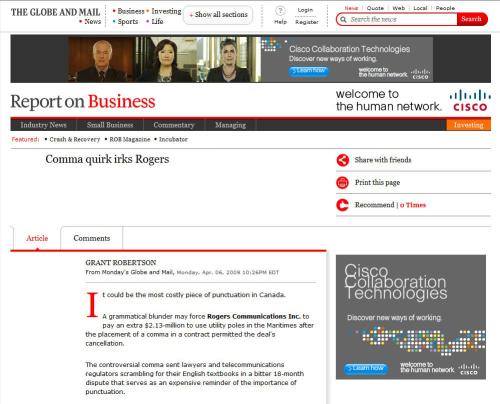August 31, 2009 by grammarcops
Wayne, from Blaine, Minnesota, USA, writes:
AP headline needs a comma
Headline reads: “Analysis: Summer vacation is over Obama”
Yahoo’s edition has the comma missing: (click here to view)
And so does the version on the AP’s site: (click here to view)
Do YOU know where the comma should go? Please comment.

Posted in comma clout, comma confusion, craves a comma | Tagged AP, comma, English, headline, news, Obama, punctuation, use, vacation, Web, writing, Yahoo | 6 Comments »
July 17, 2009 by grammarcops
This tweet (from Twitter) needs a comma … where would you place it?
@EONpr: “Grammar Gossip pop quiz for pr scribes and copywriters from the Business Wire blog”
(click here for the story)

Without Comma Clout, it sounds as if the pop quiz is ONLY for those from the Business Wire blog.
With Comma Clout, the Business Wire blog pop quiz is for all PR scribes and copyrighters.
Be sure to enjoy the quiz!
Shameless plug for our sister site, Grammar Police a.k.a. GrammarCops: See the post Special effects (and affects) …

Posted in comma clout, comma confusion, craves a comma | Tagged @EONpr, @GrammarCops, affect vs. effect, blog, business, Business Wire, comma, communication, copywriter, English, grammar, Grammar Gossip, Grammar Police, pop quiz, punctuation, scribe, tweet, Twitter, use | Leave a Comment »
July 6, 2009 by grammarcops
A loyal reader sent us this photo and asks:
“Where’s the comma? Look at the caption of this picture. Must have been quite a press conference.”

Photo source: LIFE Magazine, Robert McNamara: Life and Times

Posted in comma clout, comma confusion, craves a comma | Tagged comma, English, LIFE Magazine, needed, news, punctuation, required, Robert McNamara, writing | Leave a Comment »
June 23, 2009 by grammarcops
A lot of buzz around this issue today … Barrett got us blogging when he sent this tweet:

Per Wiki, the serial comma (also known as the Oxford comma and the Harvard comma) is the comma used immediately before a grammatical conjunction (usually and, or, and sometimes nor) preceding the final item in a list of three or more items. More simply, as per AskOxford.com, the ‘Oxford comma’ is an optional comma before the word ‘and’ at the end of a list.
For example, this three-media list can be punctuated as either “Linkedin, Facebook, and Twitter” (with the serial comma) or as “Linkedin, Facebook and Twitter” (without the serial comma).
There is no consensus among writers and editors on the usage or avoidance of the serial comma. Most American English authorities recommend its use, but it seems to be less frequent in British English. In many languages (e.g., French, German, Italian, Polish, Spanish) the serial comma is not the norm; it may even be explicitly forbidden by punctuation rules – but it may be allowed or even recommended in some cases to avoid ambiguity or to aid understanding when reading.
Wikipedia actually has an excellent section on this topic. Take a look:
Contents
1 Arguments for and against
2 Ambiguity
3 Usage
4 References & External links
We have relaxed our own position on the use of the serial comma. Before text limits of 140 characters or thereabouts, we would insist, but now, we say lose any extra character you can while preserving meaning.
There are many views on this little mark. Click here to read one solution. What’s your view?
Posted in comma clout, comma confusion, comma drama | Tagged blog, comma, English, Harvard, issue, mark, Oxford, punctuation, serial, Web, Wiki | 7 Comments »
June 19, 2009 by grammarcops
On Twitter today, we saw this interesting profile:
“I find and mock punctuation errors on my blog, Apostrophe Catastrophes.”

(click here to see the blog)
We love their site … and, we refer to it frequently.
We would like to take this opportunity to recommend some comma clout for their Twitter profile.
As is: “I find and mock punctuation errors on my blog, Apostrophe Catastrophes.” This sounds as if they correct only their own blog errors …
With comma clout: “I find and mock punctuation errors, on my blog, Apostrophe Catastrophes.”
Even better: “I find punctuation errors and mock them on my blog, Apostrophe Catastrophes.”
Posted in comma clout, comma confusion, craves a comma, other punctuation perils | Tagged apostrophe, blog, catastrophe, comma, English, fun, needed, punctuation, reference, site, use, Web | 1 Comment »
June 16, 2009 by grammarcops
On Twitter today, we saw a great retweet that we had to mention on our blog:
“RT … i’ve seen it … Let’s eat Grandpa. Let’s eat, Grandpa. Grammar saves lives!”
What a fantastic example of comma clout! Thanks for the update.
Posted in comma clout, comma drama, other punctuation perils | Tagged blog, comma, communication, English, grandpa, important, let's eat, lives, punctuation, retweet, save, tweet, Twitter, use, Web | 1 Comment »
June 16, 2009 by grammarcops
We are always looking for comma clout … we crave instances in which the comma is required, supported, and even touted.
Today, we found another such situation in an article about business writing in email. (click here to read the entire post)
Here are a few excerpts we wish to emphasize:
“1. Use a comma after “Hi” or “Hello” in your greeting. Omitting the comma after the initial greeting in an e-mail (such as “Hi Calmetta”) is so commonplace that it may eventually become standard usage. Until that happens, though, leaving out the comma can send the message right off the bat that the writer does not understand punctuation rules. And that’s the wrong message to send when you’re not sure whether a boss or potential employer is a stickler on writing rules.”
Here is the general guideline: Use commas to set off the name of a person written to in a direct address. (Example: Hi, John.) Note that this greeting is different from “Dear John,” which is often used in writing letters. “Dear John” doesn’t require a comma because “dear” is an adjective – adding a single-word description to the name of the person you are addressing. However, both “Dear John” and “Hi, John” require punctuation after John to set off the name at the beginning of a letter or e-mail. For “Dear John,” use a comma; after “Hi, John,” use either a period or a dash.
And …
“4. Avoid too-casual closings. Ending messages with a standard sign-off such as “See ya” or “Later” can add a touch of your personality when communicating with friends, but play it safer in business e-mails. Opt for a standard complimentary closing such as “Sincerely,” “Respectfully” or “Thanks in advance.” And remember to use a comma after the closing before adding your name on the next line.”
Thanks to Calmetta Coleman of culpwrit.
Posted in comma clout, craves a comma | Tagged article, blog, business, Calmetta Coleman, comma, email, English, important, needed, post, punctuation, required, support, tout, use, Web, writing | 1 Comment »
June 11, 2009 by grammarcops
We were thrilled when we got the new Palm® Prē™phone. Never mind all of the nifty new features, the sleek design, the lightning-fast response, etc., that we could go on and on about. Look at the comma clout! Finally, an important punctuation mark, our favorite, of course, that is available without an auxiliary key. We were compelled to feature it in our blog. Thanks, Palm!

Posted in comma clout | Tagged comma, feature, important, key, mark, new, Palm, phone, Pre, punctuation, sleek | Leave a Comment »
June 5, 2009 by grammarcops
Of course, we just had to post this article from The Globe and Mail! Now, this is true comma clout!
“Comma quirk irks Rogers”
(click here for the true story)

Posted in comma confusion, other punctuation perils | Tagged comma, communication, English, Globe and Mail, headline, million, news, punctuation, quirk, Rogers, Web | Leave a Comment »
June 1, 2009 by grammarcops
Got this spam/phishing email today about unusual bank activity and a possible suspension of a bank account … yeah, right.
Anyway, the email is in need of the Grammar Police and Comma Clout, so here goes.
“Dear Bank Customer_ ,
Because of unusual number of invalid login attempts on your account, we had to believe that, their might be some security problem on your account…”
Comma Clout needed:
- remove the space before the comma in the greeting: “Dear Bank Customer,“
- remove the comma before the incorrectly-used “their” in the first sentence: “… we had to believe that …”
Grammar Policing needed: “their” should be “there:” “… we had to believe that there might be …”
See the Grammar Police blog post: “There you have it …” for more on There vs. Their (and They’re).
Posted in comma confusion, comma surplus | Tagged bank, comma, email, English, GrammarSpammer, phish, spam | 1 Comment »
Older Posts »






